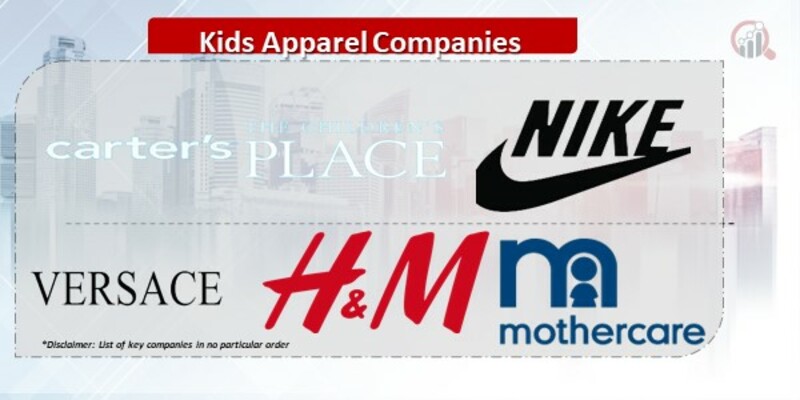Top Industry Leaders in the Kids Apparel Market
 Kids Apparel Market Outlook
Kids Apparel Market Outlook
The Kids Apparel Market is a dynamic and rapidly evolving sector, influenced by changing consumer preferences, fashion trends, and the global economic landscape. This analysis delves into the competitive landscape of the industry, exploring key players, strategies employed, market share factors, emerging companies, and the latest industry developments.
Key Players:
- Carter’s, Inc
- The Children's Place, Inc
- Nike, Inc
- Gianni Versace S.r.l
- Industria de Diseño Textil, S.A
- Hennes & Mauritz AB
- Mothercare plc
- Cotton On Group
- Burberry
- Gerber Childrenswear LLC
Strategies Adopted:
Key players are employing diverse strategies to stay ahead in the highly competitive Kids Apparel Market. This includes a focus on sustainable and ethically sourced materials, as eco-conscious consumers drive demand for environmentally friendly clothing. Customization and personalization options are also becoming increasingly popular, allowing brands to connect with their young customers on a more individual level. Furthermore, strategic collaborations with popular children's characters, influencers, and designers contribute to brand visibility and appeal.
Factors for Market Share Analysis:
Several factors contribute to the market share dynamics within the Kids Apparel Market. Brand reputation and recognition are crucial, as parents often prefer trusted and well-known labels when purchasing clothing for their children. Quality, durability, and pricing strategies are also pivotal factors influencing consumer choices. The ability to adapt quickly to emerging fashion trends and consumer preferences further contributes to a brand's market share, as does an effective omnichannel presence, encompassing both physical stores and online platforms.
New and Emerging Companies:
The Kids Apparel Market is witnessing the emergence of innovative and niche players that cater to specific consumer segments. Start-ups such as Primary, Rockets of Awesome, and Mini Boden have gained traction by focusing on unique designs, sustainable practices, and direct-to-consumer models. These companies often capitalize on the digital landscape, leveraging social media and e-commerce platforms to connect with their target audience directly.
Industry News and Trends:
Recent industry trends reflect a growing emphasis on sustainability, with many established players and newcomers incorporating eco-friendly practices into their supply chains. This includes the use of organic fabrics, recycled materials, and transparent sourcing processes. The rise of gender-neutral and inclusive clothing lines is also a notable trend, reflecting changing societal attitudes towards traditional gender norms. Additionally, the ongoing digital transformation of the industry, from virtual try-on experiences to augmented reality (AR) features, is reshaping the way consumers interact with and purchase kids' apparel.
Current Company Investment Trends:
Investments in technology and supply chain optimization remain a focal point for companies looking to enhance efficiency and reduce costs. Automation and data analytics are increasingly being employed to streamline manufacturing processes and improve inventory management. Moreover, investments in online platforms and digital marketing strategies continue to be a priority, as the shift towards e-commerce accelerates. Brands are also exploring strategic mergers and acquisitions to expand their product offerings, enter new markets, or strengthen their competitive position.
Overall Competitive Scenario:
The competitive landscape of the Kids Apparel Market is marked by a delicate balance between established giants, innovative start-ups, and evolving consumer preferences. Adapting to the fast-paced nature of the industry is crucial for sustained success. Brands that can seamlessly blend traditional retail with e-commerce, embrace sustainability, and respond swiftly to emerging trends are poised to navigate the competitive terrain effectively. As the market continues to evolve, collaboration, innovation, and a keen understanding of the diverse needs of parents and children alike will be integral to maintaining and expanding market share in the dynamic Kids Apparel Market.

